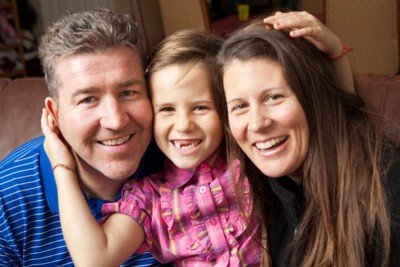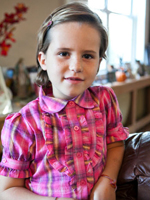Caitlin’s Story
Caitlin was diagnosed at the age of three with a central nervous system tumor known as optic pathway glioma behind her left eye. Two years later, the tumor grew and Caitlin was at risk of losing her sight. Her parents sought treatment with the pediatric brain tumor team at Memorial Sloan Kettering, where Caitlin underwent an extensive regimen of chemotherapy.

Caitlin Mullin was born with a cataract, which was screened every three months throughout her young life by a pediatric ophthalmologist at the Mullin’s local hospital on Long Island, New York. During one of these routine screenings, the ophthalmologist noted that Caitlin’s left optic nerve was swollen. Around the same time, she developed trouble with her eyesight and had to start wearing glasses. The doctors explained to her parents, Chrissy and Terence, that there were two possible causes for these developments: it was either an anomaly she had been born with or it was a new growth.
We Were in Shock
“She’d been screened since she was a newborn,” Chrissy says, “so we knew she hadn’t been born with it. Still, I wasn’t that worried. The doctors told us that it could easily go away on its own.” Caitlin was sent for an MRI, the results of which came as a terrible surprise to the Mullins: Caitlin had an optic nerve tumor known as an optic pathway glioma (also called optic nerve glioma) behind her left eye. “We were in shock,” Chrissy recalls.
The doctors at their Long Island hospital recommended that the Mullins schedule an appointment with pediatric neurologist Roger Packer at the Children’s National Medical Center in Washington, DC. After Dr. Packer examined Caitlin, he explained that she was a very unusual case. Such tumors in children can be associated with neurofibromatosis, a genetically inherited disorder in which tumors develop on nerve tissue. But of the seven disease markers that usually go along with neurofibromatosis, Caitlin only had two. Since the tumor did not appear to be life-threatening, Dr. Packer advised the Mullins to watch for any changes in the tumor and in Caitlin’s vision, a process known as active surveillance, rather than to treat it at that time. “We went for a second opinion, which confirmed this advice, so we were all pretty relieved,” Terence explains.
As part of her active surveillance plan, Caitlin received regular eye exams and MRI screening tests — initially every three months, and then, after a year, every six months. There was no sign of tumor progression until June 2008, when the MRI revealed that the tumor had grown.
“Our local doctors told us that the tumor had grown significantly and that we needed to discuss treatment options,” Chrissy remembers. “The way they described it, Caitlin would need to go through 64 weeks of chemotherapy. Her immune system would be compromised, which meant she wouldn’t be able to go to school for that entire period. The picture they painted was pretty scary.”
Caitlin was just five years old at the time, so the Mullins explained everything to her in the gentlest way possible. “She was so young,” Chrissy says. “We told her that she had a lump on her eye and that she would need to get some special medicine to shrink it.”
A friend of the Mullins had a daughter who had developed a rare cancer of the sympathetic nervous system known as neuroblastoma. Because her daughter had been successfully treated for her cancer at Memorial Sloan Kettering Cancer Center, the girl’s mother suggested that Chrissy bring Caitlin there for a second opinion about treatment options. Chrissy was referred to Memorial Sloan Kettering pediatric oncologist Ira Dunkel, who specializes in the care of children, teenagers, and young adults with brain and eye tumors.
“I called and left a message, and he called me back the very next day,” Chrissy recalls. “I had never met the man before, and he ended up talking with me on the phone for half an hour.”
Going to Memorial
After sending all of Caitlin’s scans, her parents scheduled an appointment for her with Dr. Dunkel’s colleague on the pediatric brain tumor team, pediatric neurologist Yasmin Khakoo. Dr. Khakoo examined Caitlin, reviewed her scans, and agreed that treatment was necessary.
“This sounds stupid,” Chrissy says, “but I initially considered going to our local hospital for the treatment because it was easier logistically than going into Manhattan. But then one of my friends reminded me that we lived 45 minutes from one of the best cancer hospitals in the country. Once I met Dr. Khakoo and the other doctors and saw the facilities, there was no more debate. Caitlin was going to Memorial.”
Caitlin’s treatment started on October 10, 2008, when she had a port surgically placed under the skin in her chest. (A port is a small medical appliance that uses a catheter connected to a vein to allow chemotherapy to be injected into the bloodstream.) Her chemotherapy regimen, which included the drugs vincristine and carboplatin, would last 64 weeks, following a schedule of ten weeks of active treatment followed by two weeks of rest.
During an “on” week, Caitlin would come into the hospital on either a Thursday or Friday to receive her chemo infusion for the week. “Her first day back on treatment after a break was when Caitlin felt the most nauseous,” Chrissy explains. “But they started us on some new antinausea pills that helped. Either way, the nausea went away after about a day or a day and a half, and she was fine the rest of the cycle.”
Before each chemotherapy session, Caitlin had to undergo a neurological examination. “Caitlin was always playing and jumping around during the exam,” Chrissy remembers. “I’d get frustrated and say, ’Caitlin, sit down!’ But at one point, Dr. Gilheeney [pediatric oncologist Stephen Gilheeney was one of the doctors on Caitlin’s treatment team] said to me, ’I know where you’re coming from, but we love this. We don’t get this that often.’”
While the doctors at her local hospital had warned that Caitlin would be unable to attend school during this period, Dr. Khakoo was of a different opinion. “When we asked her about school,” Chrissy remembers, smiling, “Dr. Khakoo’s response was, ’Of course she has to go to school! Why wouldn’t she?’”
64 Weeks
At the beginning of the treatment regimen, Chrissy and Terence Mullin wondered how they would make it through the 64 weeks.

Caitlin Mullin
“But the doctors at Memorial and the nurses — especially the nurses — including Caitlin’s favorite, Maureen Higgins, they all made it as comfortable and bearable an experience as possible,” Chrissy explains.
“Maureen is now one of our best friends. She and the rest of the nurses are there for you whenever you have a question or a problem. You receive all this love and attentiveness from everyone, which makes you feel like your child is the only kid there.”
To make the time spent in the hospital go faster, Caitlin liked to keep busy. “There would be two or three hours out of the day that we wouldn’t even see her,” Chrissy says, laughing. “She took a ’tween’ drama class for kids aged eight to 12 … when she was only five. She was always cooking or doing art projects with the child life specialists in the Recreation Center — all while hooked up to her chemo IV pole.”
As often happens, Caitlin experienced some chemotherapy-induced side effects. The first was weakness in one foot caused by neuropathy, a condition of the peripheral nervous system that can cause pain, numbness, and muscle weakness. The second, more obvious side effect was hair loss.
A Touching Show of Support — Bandanas and Baseball Caps for All
“The hair loss started one night when Caitlin was in the bathtub,” Chrissy recalls. “Her hair started falling out in clumps. It really upset her, so I called her teacher, Mrs. Lindner, and told her what had happened and that Caitlin would need to wear a hat to school the next day, which was normally against the school rules.” When Caitlin arrived at St. Francis De Sales in Rockaway, Queens, the next morning, the entire first grade was wearing pink bandanas and baseball caps in a show of support for their classmate after Mrs. Lindner had spent the night calling every family. The Mullins still tear up at the memory of that day. “That’s one of the real pluses with living in a small, close-knit community. We received so much support from our friends and neighbors, and it made all the difference.”
Fortunately for Caitlin, her doctors were able to adjust her medication doses to address the neuropathy, and her hair grew back before the end of her treatment, in November 2009. As hoped, the tumor shrunk back to its original size and, as a result of the treatment, it is no longer growing. And, most importantly, her vision remains unaffected. Caitlin now goes for MRI surveillance every three months.
Looking back, the Mullins are amazed at how their view of treatment changed over time. “It went from being overwhelming in the beginning to just being a normal part of our lives,” Terence says. “I’d go to work on Monday, Tuesday, and Wednesday, go to Memorial Sloan Kettering on Thursday, and then go back to work on Friday. When people heard about what we were going through and asked how we managed, the answer was pretty simple: You have no choice. No matter how hard it is, you do whatever’s necessary.”
Caitlin, the Rock Star
“You wouldn’t think it from looking at her, but Caitlin is very tough,” Terence says with pride. “She plays on two weekly soccer teams and performs in a step-dancing troupe, and she never let her treatments stop her from participating in any of them.” The Mullins point to one week in particular as an example of Caitlin’s resilience, when after finishing a chemotherapy treatment on a Friday, she played a soccer game the following day, after waking up in the morning feeling ill. “She woke up sick, but she told us that she wanted to play,” Chrissy marvels. “They had to stop the clock three times for her, but she ended up playing the whole game. Dr. Gilheeney calls her a rock star, and we totally agree.”


